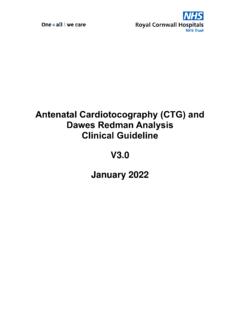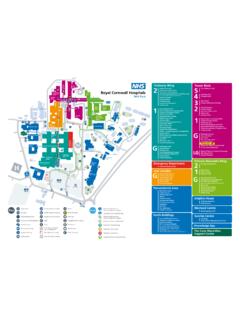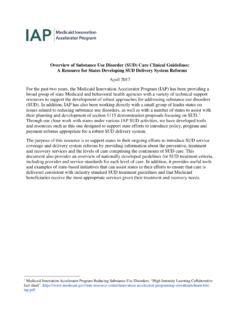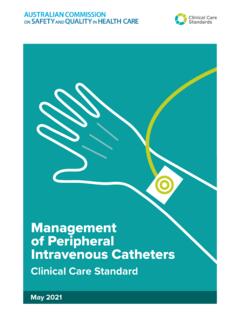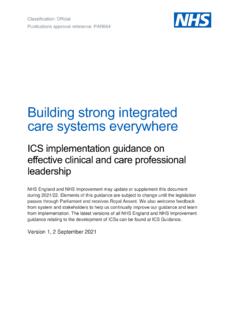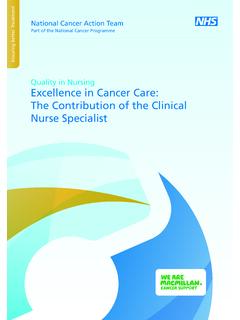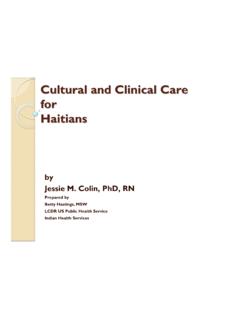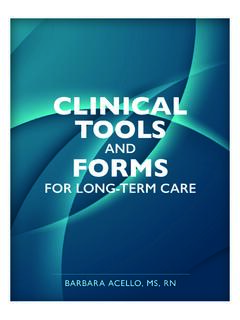Transcription of Wound Care Clinical Guideline V1.1 March 2021
1 POLICY UNDER REVIEW Please note that this policy is under review. It does, however, remain current Trust policy subject to any recent legislative changes, national policy instruction (NHS or Department of Health), or Trust Board decision. For guidance, please contact the Author/Owner. Information Category Detailed Information Document Title: Wound care Clinical Guideline This document replaces (exact title of previous version): Wound care Clinical Guideline Date Issued/Approved: March 2021 Date Valid From: March 2021 Date Valid To: July 2022 Directorate / Department responsible (author/owner): Heather Newton Tissue Viability Consultant Nurse Contact details: 01872 252673 Brief summary of contents: Wound Assessment. Wound Management Formulary guidance Suggested Keywords: Wound care .
2 Wound dressings. Wound dressing formulary Target Audience: RCHT: Yes CFT: No KCCG: No Executive Director responsible for Policy: Chief Nurse Approval route for consultation and ratification: Tissue Viability Link Practitioners Consultant Surgeons Tissue Viability team CFT Infection Prevention and Control team General Manager confirming approval processes: Louise Dickinson Information Category Detailed Information Name of Governance Lead confirming approval by specialty and care group management meetings: Kevin Wright Links to key external standards: None required Related Documents: Cowan T (2014) Wound care Handbook 7th edition. MA Healthcare. Dowsett C (2011) Moisture in Wound healing: exudate management. British Journal of Community nursing 16 (supp 4) S6-12 European Wound Management Association (EWMA) (2008) Position document: Hard to heal wounds: A holistic approach.
3 London. MEP Ltd. science applied to practice. Introduction in Wound bed preparation. EWMA Position document. MEP Ltd. Guest et al. Health economic burden that wounds impose on the National Health Service in the UK. 2015 BMJ. LeBlanc, K. Baranoski, S. (2011) Skin Tears: State of the Science: Consensus Statements for the Prevention, Prediction, Assessment, and Treatment of Skin Tears. Adv Skin Wound care ; 24(9):2-15 Information Category Detailed Information Ousey K, Cook L (2012) Wound assessment Made easy. Wounds UK Vol 8 No 2. Simon et al. Skin Wound Healing. 2016. Medscape. Stephen-Haynes, J. & Carville. (2011) Skin Tears made Easy. Wounds International 2(4) November. easys/skin-tears-made-easy/page-1 Vandeputte J, Hoekstra H (2006) Observed hyper granulation may be related to oedema of granulation tissue.
4 Wounds International. Wound Infection in Clinical Practice. International Wound Infection Institute. 2016. London Wounds UK (2013) Best Practice statement. The use of Topical Antimicrobial Agents in Wound Management. London. Training Need Identified? YES Workshops provided on a regular basis throughout the year Publication Location (refer to Policy on Policies Approvals and Ratification): Internet & Intranet Document Library Folder/Sub Folder: Clinical / Infection Prevention & Control This document is only valid on the day of printing Controlled Document This document has been created following the Royal Cornwall Hospitals NHS Trust Policy on Document Production. It should not be altered in any way without the express permission of the author or their Line Manager.
5 Wound care Clinical Guideline March 2021 Wound care Clinical Guideline Page 2 of 26 Wound care guidelines Roles and responsibilities are outlined in section 4 For Wound assessment principles refer to section 5 For Wound management and formulary guidance refer to section 6 For guidance on how to refer to the Tissue Viability service see section Summary Wound care Clinical Guideline Page 3 of 26 Data Protection Act 2018 (General Data Protection Regulation GDPR) Legislation The Trust has a duty under the DPA18 to ensure that there is a valid legal basis to process personal and sensitive data. The legal basis for processing must be identified and documented before the processing begins. In many cases we may need consent; this must be explicit, informed and documented.
6 We cannot rely on opt out, it must be opt in. DPA18 is applicable to all staff; this includes those working as contractors and providers of services. For more information about your obligations under the DPA18 please see the Information Use Framework Policy or contact the Information Governance Team 1. Aim/Purpose of this Guideline The provision of effective Wound care is dependent on a systematic and holistic individualised patient approach together with sound knowledge of anatomy and physiology, Wound healing principles and appropriate Wound management dressings. Financial costs of managing acute and chronic wounds continue to rise and are estimated to be billion per year. Guest et al (2015). Human costs of living with a Wound cannot be measured however they include social isolation, impaired quality of life, pain and debilitation and potential loss of income.
7 Wound healing is a natural restorative response to tissue injury which involves the interaction of a complex systematic cascade of cellular phases; haemostasis, inflammation, proliferation and maturation to restore injured skin. Simon et al (2016) This Guideline aims to provide an evidence-based framework for the assessment and management of acute and chronic wounds in accordance with local and national guidelines . It is intended to be used by all staff employed within the Royal Cornwall Hospitals NHS Trust. (RCHT). This Guideline supports the use of the Cornwall Health Community joint Wound dressing s formulary which has been developed in collaboration with RCHT, CFT and the CCG. The Guideline should be used as an adjunct to Clinical judgement and individualised holistic patient assessment.
8 This version supersedes any previous versions of this document. Wound care Clinical Guideline Page 4 of 26 2. The Guidance Wound Assessment principles A comprehensive, patient and Wound assessment must be completed and documented by a Registered Nurse or Assistant Practitioner using the RCHT Wound assessment tool (CHA 3903 V1) when the Wound is first identified. This should include assessment of the Wound , the surrounding skin, presence of infection or biofilm, the individual s ability to heal considering nutritional status, continence, general physical and psychological health, past and current systemic and local treatments, medications, comorbidities, environment of care , other factors influencing ability of the Wound to heal.
9 The Wound size must also be recorded. Reassessment of the Wound and the impact of the dressing plan should be undertaken according to the Wound characteristics and effectiveness of the dressing. Wound photographs can be a useful method of recording Wound characteristics. The RCHT policy re the management of information and records should be followed with specific reference to consent. The general consent to recording form CHA 2891 must be used and filed in the patient record prior to taking photographs. http://doclibrary-rcht- sTrust/HealthInformatics/CorporateAndHea lthRecords/PolicyToMa The RCHT Wound assessment tool is based on the TIME framework (Falanga 2004) which was developed by an International Advisory Board.
10 The Wound surface and the skin are also included to ensure a thorough assessment of the Wound in relation to specific criteria. T = Tissue non-viable It is important to identify any non-viable tissue at an early stage as this has the potential to lead to infection and delay in Wound healing. The Wound bed will show signs of tissue necrosis or slough which is most circumstances will require debridement. (See section ). I = Infection or Inflammation Wound infection is defined according to an infection continuum (see section ) and early recognition of subtle signs of infection is key to preventing spreading and systemic infection and sepsis. Inflammation especially if chronic will significantly delay Wound healing and must be recognised and treated for a Wound to heal.





